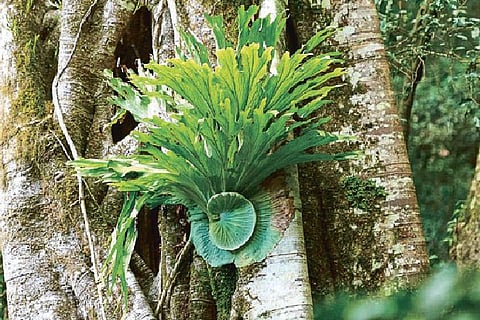

Chennai
On one hike on Australia’s Lord Howe Island, he came across a cluster of staghorn ferns. They are common potted plants, but in nature they grow in dense colonies that cling to treetops. In the volcanic island’s stunted forest, those treetops are right at eye level.
“I almost looked beyond it,” said Dr. Burns, a biologist at Victoria University of Wellington in New Zealand. Then he peered closer and realised the plants within the colony were doing different jobs to survive. Ferns growing higher up had waxy fronds that seemed to direct rainwater into the colony’s centre. Farther down, ferns grew spongier leaves that were damp to the touch. Some plants weren’t reproducing at all — they seemed to have dedicated their lives to collecting water for their neighbours’ entangled roots. It struck Dr. Burns that the ferns were working together as a kind of super-organism, perhaps like bees in a hive. In a paper, Dr. Burns and his co-authors argued colonies of the staghorn fern Platycerium bifurcatum show a collective behaviour known as eusociality. Until now, scientists had only recognised eusociality in some animals like bees or ants that live in colonies and divide their labour.
To measure how ferns divided labour, the researchers sampled plants growing at different heights within 24 colonies. They counted two types of leaves on each plant. One type, which they called nest fronds, are rounded and mostly brown, clasping the tree like cupped hands. Other fronds, green and forked like antlers, can grow spores on their undersides that will become the next generation of ferns.
Plants closer to the top of each colony had more spore-bearing fronds. Plants near the bottom had more of the cupped, non-reproducing nest fronds. About 40 percent of individual plants weren’t reproducing at all, like worker bees. Next the scientists cut out wedges from nest fronds, dried them, then soaked them in water to measure how much they sopped up. They found that nest fronds from the bottom of a colony were more absorbent. Since the colony’s roots grew in a tangled network, these spongy leaves might help the whole colony stay hydrated. The scientists found that larger colonies (the biggest one they studied held 58 individual ferns) had more spore-bearing fronds per capita. Living in a big group, then, might improve the ferns’ fitness.
For the most part, the groups are families. “We realised the genetics is important,” Dr. Burns said, because eusocial animals live in closely related groups. When researchers analysed DNA from 11 fern colonies, they found that most plants within a colony were as closely related as possible: They were clones. New plants arise from buds in the root systems of others, Dr. Burns said. Being clones “means that the different individuals have aligned interests genetically,” said Guy Cooper, an evolutionary biologist at the University of Oxford. By helping a neighbouring clone, a plant is also helping its own genes survive.
Dr. Cooper said he would like to know more about the life cycle of a colony, and how much the individual ferns depended on one another. Plants are some of the most flexible living things on Earth, said Karen Kapheim, a biologist at Utah State University who studies the evolution of social behavior in bees. Maybe it’s not surprising that a fern could also evolve social tendencies, she said. Science is revealing more and more about how plants behave and communicate, Dr. Kapheim said. “I think adding social behavior to that fits in with this new, emerging understanding of plants.”
Elizabeth Preston is a reporter with NYT©2021
The New York Times
Visit news.dtnext.in to explore our interactive epaper!
Download the DT Next app for more exciting features!
Click here for iOS
Click here for Android